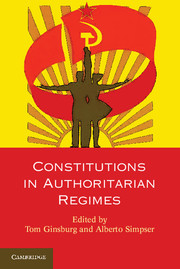Book contents
- Frontmatter
- Contents
- List of Contributors
- 1 Introduction
- Part I The Category
- Part II Constitutional Design in Authoritarian Regimes
- Part III Contents of Authoritarian Constitutions
- 7 The Content of Authoritarian Constitutions
- 8 Constitutional Variation among Strains of Authoritarianism
- Part IV Consequences of Authoritarian Constitutions
- Index
- References
7 - The Content of Authoritarian Constitutions
Published online by Cambridge University Press: 05 June 2014
- Frontmatter
- Contents
- List of Contributors
- 1 Introduction
- Part I The Category
- Part II Constitutional Design in Authoritarian Regimes
- Part III Contents of Authoritarian Constitutions
- 7 The Content of Authoritarian Constitutions
- 8 Constitutional Variation among Strains of Authoritarianism
- Part IV Consequences of Authoritarian Constitutions
- Index
- References
Summary
“What is the difference,” went an old joke in the Soviet Union, “between the Soviet and U.S. constitutions? The Soviet constitution guarantees freedom of speech; the U.S. constitution guarantees freedom after speech.” The joke captures the common intuition about the function (or dysfunction, rather) of constitutions in authoritarian regimes. Many other examples abound: citizens of North Korea might be surprised to learn that they are guaranteed rights to free speech, assembly, and association, while the constitution of Niger guarantees each citizen the right to health and education, notwithstanding the fact that the country ranks 182nd out of 182 countries rated by the Human Development Index.
If we are to generalize from these phenomena, we might expect that there is little difference between constitutions written by dictators and those written by democrats. There is certainly anecdotal evidence to support this expectation. The entrenchment of human rights in constitutions has been nearly universal, with both authoritarian and democratic constitutions incorporating an increasing number of rights. Similarly, the vast majority of constitutions at least mention the word “democracy” (approximately 90 percent of those in force in 2006). We are not the first to note the commonality between institutions in authoritarian and democratic regimes. An entire literature in comparative politics has evolved to understand why dictators adopt multiparty legislatures (Gandhi and Przeworski 2007), elections (Schedler 2006), and relatively autonomous judiciaries (Ginsburg and Moustafa 2008). In general, it is thought that such institutions provide information that is used by dictators to prolong their tenure.
- Type
- Chapter
- Information
- Constitutions in Authoritarian Regimes , pp. 141 - 164Publisher: Cambridge University PressPrint publication year: 2013
References
- 7
- Cited by



